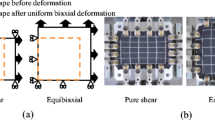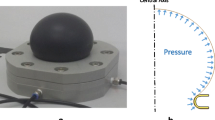Abstract
This paper presents a review on the effect of rubber membranes on the measured stress and volume change data during the triaxial tests. In many instants, the error associated due to membrane penetration is measured to be close to the total sample volumetric strains. Hence, in addition to precise measurements, adopting an appropriate correction to the measured data is pivotal. This paper provides a detailed review on the methods used to estimate and reduce the influence of rubber membrane on the measured triaxial test results. The discussion therefore clearly highlights the stiffness, thickness, and diameter of the membrane used, to have significant influence on the measured deviatoric stress and the volume change data. The mean grain size of sample has an equally significant influence on the volume change. The methods in general are limited to test conditions, and therefore, it is practically uncertain to have a generalized correction procedure. Effectively, the outcome from this review work enhances the understanding of the reader towards the effect, methods, and corrections to be considered in triaxial testing due to rubber membrane and membrane penetration effects.





Similar content being viewed by others
Abbreviations
- A c :
-
Post-consolidation average cross sectional area of the sample
- A m :
-
Area of contact between the membrane and the sample
- A s :
-
Soil surface area covered by the membrane
- α :
-
Angle of the failure plane
- D c :
-
Post-consolidation diameter of the sample
- d 50 :
-
Mean grain size
- d :
-
Sample diameter
- d g :
-
Equivalent diameter when converted to spherical shape
- d m :
-
Membrane diameter
- V 0 :
-
Sample volume prior to change in stress
- ΔV T :
-
Total volume change
- ΔV m :
-
Volume change caused by membrane penetration
- ΔV Soil :
-
Volume change caused by soil deformation
- ΔV T :
-
Total volume change
- Δv m :
-
Membrane effect unit area (Δv m = ΔV m/A m)
- E m :
-
Stiffness of the rubber membrane
- ε a :
-
Axial strain
- ε m :
-
Unit membrane penetration or membrane penetration per unit membrane surface area
- ε v :
-
Total volumetric strains
- ɛ vm :
-
Volumetric strains due to membrane penetration
- q m :
-
Membrane resistance
- σ 1 :
-
Major principle stress
- σ 2 :
-
Intermediate principle stress
- σ 3 :
-
Minor principle stress
- σ 3m :
-
Minor principle stress due to membrane restraint
- σ ′c :
-
Effective confining pressure
- σ r :
-
Resultant force
- σ m :
-
Membrane restraint force
- t m :
-
Thickness of the membrane
- u :
-
Pore water pressure
References
Al-Karni AA (2011) Evaluation of shear strength of cohesionless soil due to excess pore water pressure. Arab J Geosci 4(7–8):1095–1101
ASTM D 4767-11: Standard test method for consolidated undrained triaxial compression test for cohesive soils. ASTM International 2011, West Conshohocken, PA, USA
Baldi G, Nova R (1984) Membrane penetration effects in triaxial testing. J Geotech Eng 110(3):403–420
Bishop AW, Henkel DJ (1962) The measurement of soil properties in the triaxial test. Arnold, London, 13
Bohac J, Feda J (1992) Membrane penetration in triaxial tests. Geotech Test J 15(3):288–294
Choobbasti AJ, Farrokhzad F, Barari A (2009) Prediction of slope stability using artificial neural network (case study: Noabad, Mazandaran, Iran). Arab J Geosci 2(4):311–319
De Beer EE (1950) The cell test. Geotechnique 2(2):162–172
Della N, Belkhatir M, Henni AD, Canou J, Dupla JC (2013) Laboratory assessment of saturation and sample molding effects on shear resistance and mechanical characteristics of sandy soil. Arab J Geosci. doi:10.1007/s12517-013-1046-7
El-Sohby MA, Andrawes KZ (1972) Deformation characteristics of granular material under hydrostatic compression. Can Geotech J 9(9):338–350
Evans MD (1992) Density changes during undrained loading—membrane compliance. J Geotech Eng 118(12):1924–1936
Fleming HD (1952) Undrained triaxial compression tests on a decomposed Plyllite. First Australia-New Zealand Conf. on Soil Mech. and Foundation Engg 112–122
Frydman S, Zeitlen JG, Alpan I (1973) The membrane effect in triaxial testing of granular soils. J Test Eval 1(1):37–41
Greeuw G, Adel HD, Schapers AL, Haan EJD (2001) Reduction of axial resistance due to membrane and side drains. Soft ground tech. Geotech Sp Pub GSP-112, ASCE, 30–42
Head KH (1998) Manual of soil laboratory testing: effective stress tests. John Wiley, London
Henkel DJ, Gilbert GD (1952) The effect measured of the rubber membrane on the triaxial compression strength of clay sample. Geotechnique 3(1):20–29
Irgens F (2008) Continuum mechanics. Springer-Verlag Publication, Heidelberg, pp 42–81
Kiekbusch M, Schuppener B (1977) Membrane penetration and its effect on pore pressures. J Geotech Eng Div 103(GT11):1267–1279
Kramer SL, Sivaneswaran N (1989) A non-destructive, specimen-specific method for measurement of membrane penetration in the triaxial test. Geotech Test J 12(1):50–59
Lade PV, Hernandez SB (1977) Membrane penetration effects in undrained tests. J Geotech Eng Div 103(GT2):109–125
LaRochelle P, Leroueil S, Trak B, Blais-Leroux L, Tavenas F (1988) Observational approach to membrane and area corrections in triaxial tests. Adv Triaxial Test Soil Rock STP 977:715–731
Lin H, Selig ET (1987) An alternative method for determining the membrane penetration correction curve. Geotech Test J 10(3):151–155
Lo SCR, Chu J, Lee IK (1989) A technique for reducing membrane penetration and bedding errors. Geotech Test J 12(4):311–316
Molenkamp F, Luger HT (1981) Modelling and minimization of membrane penetration effects in tests on granular soils. Geotechnique 31(4):471–486
Newland PL, Allely BH (1959) Volume changes during undrained triaxial tests on saturated dilatant granular materials. Geotechnique 9(4):174–182
Nicholson PG, Seed RB, Anwar HA (1993) Elimination of membrane compliance in undrained triaxial testing II. Mitigation by injection compensation. Can Geotech J 30:739–746
Noor MJM, Nyuin JD, Derahman A (2012) A graphical method for membrane penetration in triaxial tests on granular soils. J Inst Eng, Malaysia 73(1):23–30
Pachakis MD (1976) The influence of the membrane restraint on the measured strength of a soil sample failing along a single shear plane in the triaxial test. Geotechnique 26(1):226–230
Raghunandan ME (2011) Effect on cyclic response and liquefaction resistance due to desaturation of sand. PhD Thesis, Indian Institute of Technology Bombay, India
Raghunandan ME (2012) Effect of soil layering on the ground response parameters: a parametric study. Nat Hazards 63(2):1115–1128
Raghunandan ME, Juneja A, Hsiung BCB (2012) Preparation of reconstituted sand samples in the laboratory. Int J Geotech Eng 6(1):125–131
Raju VS, Sadasivan SK (1974) Membrane penetration in triaxial tests on sands. J Geotech Eng Div 100(GT4):482–489
Raju VS, Venkataramana K (1980) Undrained triaxial tests to assess liquefaction potential of sands: effect of membrane penetration. Intl. Symp. Soils Cyclic Transient Load 483–494
Roscoe KH, Schofield AN, Thurairajah A (1963) An evaluation of test data for selecting a yield criterion for soils. Laboratory Shear Testing of Soils, STP-361, Philadelphia 111–128
Sabatini PJ, Finnob RJ (1996) Effect of consolidation on strain localization of soft clays. Comput Geotech 18(4):311–339
Seed RB, Anwar HA, Nicholson PG (1989) Elimination of membrane compliance effects in undrained testing. 12th Intl Conf Soil Mech Found Eng 1:111–114
Sivathayalan S, Vaid YP (1998) Truly undrained response of granular soils with no membrane-penetration effects. Can Geotech J 35:730–739
Skempton AW (1954) The pore-pressure coefficients A and B. Geotechnique 4(4):143–147
Steinbach J (1967) Volume change due membrane penetration in triaxial tests on granular materials. PhD Thesis, Cornell University, Ithaca
Thurairajah A, Roscoe KH (1965) The correlation of triaxial compression test data on cohesionless media. 6th Intl. Conf. Soil Mech Found Eng 377–381
Vaid YP, Negussey D (1984) A critical assessment of membrane penetration in the triaxial test. Geotech Test J 7(2):70–76
Author information
Authors and Affiliations
Corresponding author
Rights and permissions
About this article
Cite this article
Raghunandan, M.E., Sharma, J.S. & Pradhan, B. A review on the effect of rubber membrane in triaxial tests. Arab J Geosci 8, 3195–3206 (2015). https://doi.org/10.1007/s12517-014-1420-0
Received:
Accepted:
Published:
Issue Date:
DOI: https://doi.org/10.1007/s12517-014-1420-0




